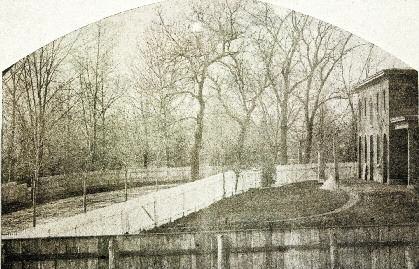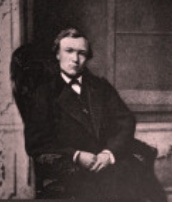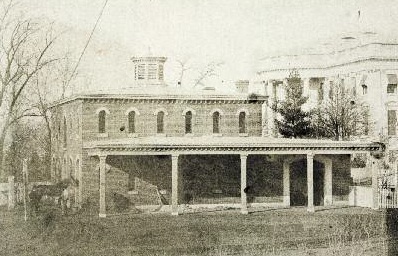Beginning in 1800 many White House stables existed over the years. In 1834 President Andrew Jackson directed the construction of a brick stable located east of the White House. This structure
was taken down in 1857, and a new stable was built on the east grounds south of the Treasury. In 1861 this building became the Lincoln family's personal stable.

The only other known view with the stable at the far right
Shortly before 8:30 P.M. on February 10, 1864, the stable caught fire. President Lincoln could see the flames from a second floor window. A guard at the White House, Sergeant Smith Stimmel, described what happened:
Just then the front door of the White House flew open with a jerk, and out came the President buttoning his coat around him, and said to me, "Where's the fire, what's burning?" I said, "It seems to be around in the vicinity of the stable." With that he started off on a dog-trot down the steps and along the way leading to the stable. When he started to go to the fire, I thought to myself, "Old fellow, you are the man we are guarding, guess I'll go along." So I struck out on the double-quick and went with him, keeping close to his side; but he took such long strikes that his dog-trot was almost a dead run for me.
As soon as we got around where we could see what was burning, we saw that, sure enough, the White House stable was on fire. Quite a crowd had gathered by the time we got there, and the fire department was at work. Mr. Lincoln asked hastily if the horses had been taken out, and when told they had not, he rushed through the crowd and began to break open one of the large doors with his own hands; but the building was full of fire, and none of the horses could be saved. The ponies belonging to the little boys and the goats were all lost in the fire. It was a brick stable, and evidently had been burning for some time before it was discovered.

Sergeant Smith Stimmel (Hanson Studio, Fargo, ND)
Another guard, Robert W. McBride, wrote:
One
night there was an alarm of fire. The White House stables
were burning. Those of us who were early on the
ground saw a tall and hatless man come running from
the direction of the White House. When he reached
the boxwood hedge that served as an enclosure to the
stables he sprang over it like a deer. As he approached
the stable he inquired if the horses had been taken out.
On learning that they had not, he asked impatiently why
they had not, and with his own hands burst open the
stable door. A glance within showed that the whole
interior of the stable was in flames, and that the rescue of
the horses was impossible. Notwithstanding this, he
would apparently have rushed in had not those standing
around caught and restrained him. It suddenly occurred
to some one that possibly the stables had been fired for
the purpose of bringing him out of the White House and
giving an opportunity to assassinate him. Captain Bennett,
of the Union Light Guard, and some others
immediately hurried him into the White House, while, by Captain
Bennett's orders, with a detail of the men of our
company, I took charge of the entrance, remaining there
on duty for several hours.
After posting the sentinels, I went inside. Mr. Lincoln,
with others, was standing in the East room, looking
at the still burning stable. He was weeping. Little
'Tad,' his youngest son, explained his father's emotion.
His son Willie had died a short time before. He was his
father's favorite, and the stable contained a pony that had
belonged to the dead boy. The thought of his dead child
had come to his mind as soon as he learned the stables
were on fire, and he had rushed out to try to save the
pony from the flames.

Robert W. McBride
David Homer Bates, manager of the War Department Telegraph Office, recalled:
Last night, when leaving the telegraph office I discovered
that the White House stables were on fire, and running back
to the War Department, where there was a call wire, I sent
an alarm to the fire-engine house above 17th Street. The
engine responded quickly, but the fire had gained too much
headway, and the stable and contents were destroyed, in-
cluding the President's three spans of carriage horses and
Willie's little pony.

David Homer Bates
There was a strong suspicion that Patterson McGee, a coachman who had been fired by Mary Lincoln on the day of the fire, was responsible for the blaze. However, despite being arrested,
the evidence against McGee was insufficient, and he was released.
John Nicolay wrote to John Hay, "Put crepe on your hat. Tonight, at about 8:30,
while Cooper was gone to his supper, the stables took fire and burned down.
The carriages and coupe alone were saved - everything else went - six horses, including
the President's, ours, and Tad's two ponies...Tad was in bitter tears at the loss
of his ponies, and his heaviest grief was that one of them had belonged to Willie."
The next day President Lincoln consoled Tad by saying that the horses had "gone where the good horses go."
The ruins of the stable were cleaned up immediately, and a few days later Congress appropriated $12,000 to build a new stable.

Stimmel's account came from Personal Reminiscences of Abraham Lincoln by Smith Stimmel (Minneapolis, W.H.M. Adams, 1928).
McBride's account came from Personal Recollections of Abraham Lincoln by Robert Wesley McBride (Indianapolis, Bobbs-Merrill, 1926).
Bates' recollection came from Lincoln in the Telegraph Office: Recollections of the United States Military Telegraph Corps during the Civil War by David Homer Bates (New York, Century Company, 1907).
The White House
Historical Association was the source of the stable photos. The photo of Stimmel came from the State Historical Society of North Dakota. The photo of McBride came from the Noble
County Courts in Albion, Indiana, where he was a judge from 1882-1888. Bates' photo is from the Library of Congress. The source of Nicolay's note to Hay was The Lincolns: Portrait of a Marriage
by Daniel Mark Epstein (New York, Ballantine Books, 2008). Epstein's book was also the source of Lincoln's comment to Tad. I also consulted The Lincolns in the White House: Four Years That Shattered a Family by
Jerrold M. Packard (New York, St. Martin's Press, 2005).





